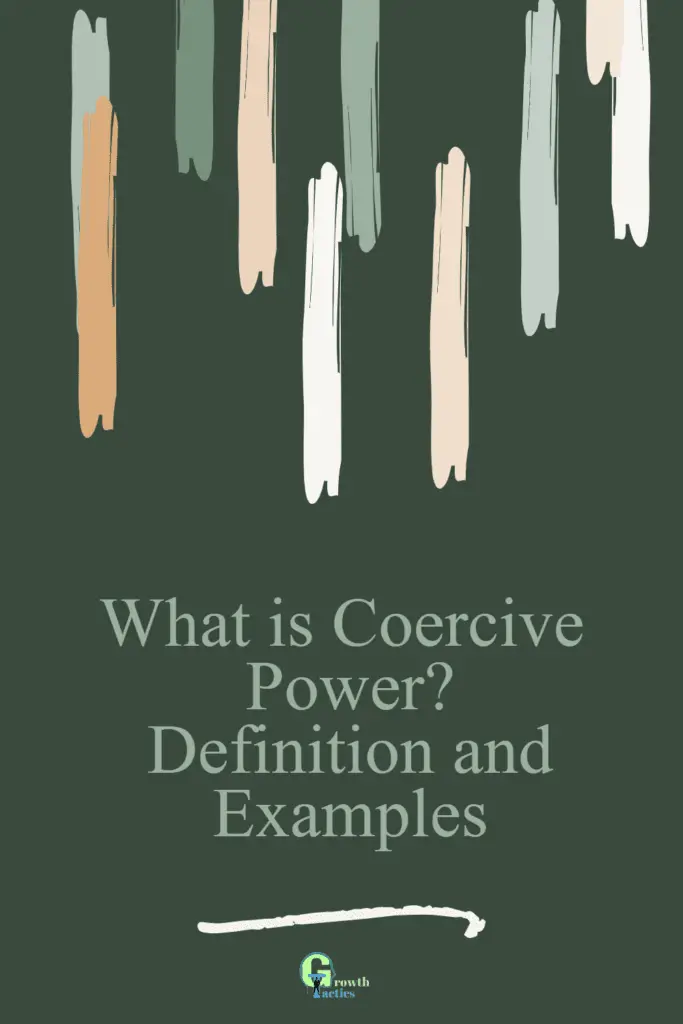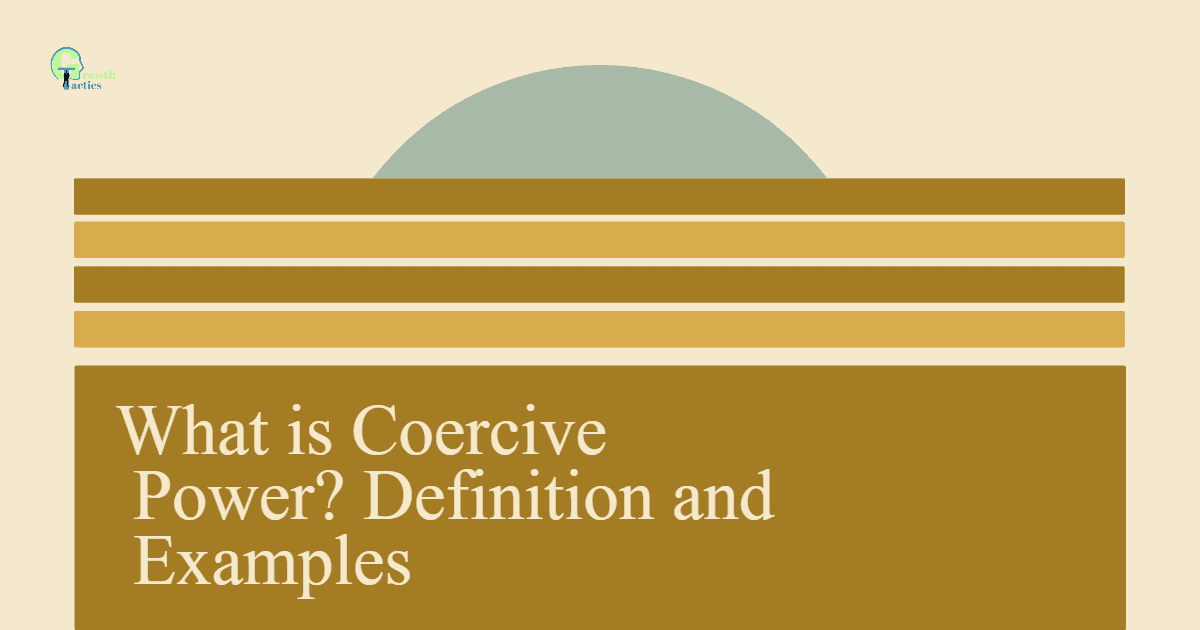Coercive power is a type of power that revolves around the use of force, threats, or punishment to influence or control others. It is one of the five types of power identified by social psychologists John R. P. French and Bertram Raven.
In this article, we will explore the concept of coercive power and its advantages and disadvantages, and examine real-life examples to deepen our understanding of this power dynamic.
Jump To Section
Understanding Coercive Power
It’s a power dynamic that can be seen in various situations, ranging from personal relationships to professional settings. Unlike other types of power, coercive power doesn’t rely on the target’s willingness to comply but rather on their fear of negative consequences.
Despite being recognized as one of the five types of power by French and Raven, coercive power has certain distinct features that set it apart from the others. While reward power, for instance, is based on the ability to offer incentives to influence others, coercive power operates by instilling a sense of fear or dread in the target.
By wielding threats or punishment, the person with coercive power attempts to exert control and maintain a certain level of authority. However, as with any type of power, the use of coercive power comes with its own set of advantages and disadvantages, which we’ll explore in the following sections.
When to Use Coercive Power
While coercive power can be effective in instilling immediate compliance and enforcing discipline, it should be wielded thoughtfully and selectively. Overuse of coercive tactics can lead to negative consequences, such as resentment, reduced morale, and decreased trust. Here are some situations where coercive power might be necessary or appropriate:
1. Emergency Situations
In high-stakes or emergency scenarios where immediate action is crucial, coercive power might be the best option to ensure compliance and resolve the situation effectively. For example, during a crisis in the workplace, a leader might enforce strict measures to guarantee safety or operational continuity.
2. Addressing Serious Misconduct
When individuals within an organization or group engage in unethical or harmful behavior, coercive power can be used to discipline them and prevent further issues. This might include issuing warnings, administering penalties, or even terminating employment for serious infractions.
3. Enforcing Non-Negotiable Policies
Certain rules or policies within an organization or institution may be non-negotiable due to legal, safety, or ethical considerations. In such cases, using coercive power to ensure adherence is crucial to uphold organizational standards and compliance.
4. Maintaining Order in Extreme Conditions
Coercive power can be effective in maintaining order in environments that are chaotic or lack structure. For instance, in authoritarian regimes or high-stress situations, this type of power may be used to restore control, though it should be balanced with efforts to rebuild trust and morale.
Best Practices:
Although coercive power may be necessary in certain contexts, it should always be paired with clear communication, fairness, and transparency to minimize its negative impact. Leaders and individuals must strive to use coercive measures sparingly and consider alternative approaches, such as reward power or referent power, when possible.

Advantages of Coercive Power
While coercive power may carry a negative connotation given its reliance on fear and punishment, it does possess certain advantages in specific situations. Understanding these advantages can shed light on the reasons why individuals may employ coercive power tactics:
1. Immediate Compliance
One significant advantage of coercive power is its ability to elicit immediate compliance. When individuals with coercive power threaten or enforce punishment, the target is often motivated to comply quickly, as they fear the negative consequences that may arise from non-compliance. This can be particularly useful in situations where time is of the essence or when there is a need for swift action or decision-making.
2. Maintaining Order and Discipline
Coercive power can be effective in maintaining order and discipline within a group or organization. By establishing clear boundaries and enforcing consequences for non-compliance, those wielding coercive power can create a sense of structure and deter individuals from engaging in behaviors that may disrupt the overall functioning of the group. This can result in increased productivity and efficiency, as well as a reduced likelihood of rule violations.
However, while there are advantages to coercive power, it’s crucial to acknowledge its limitations and potential negative impacts, which we will discuss in the subsequent sections.
Disadvantages of Coercive Power
While coercive power can be effective in eliciting immediate compliance and maintaining order, it also has several significant disadvantages and potential drawbacks. These include:
1. Resentment and Resistance
Individuals subjected to coercive power may begin to feel resentful or resistant over time. While they may comply initially out of fear, they could develop negative feelings towards the person holding power over them, particularly if threats and punishment are used frequently. This can lead to reduced motivation and morale, as well as an increased likelihood of actively working against the person holding coercive power.

2. Limited Creativity and Innovation
Coercive power can stifle creativity and innovation within a group or organization. When individuals are made to comply with specific demands, there is little room for experimentation or trying new approaches. This can limit growth and progress in the long term, as individuals stopped from pursuing alternative solutions may miss out on opportunities for improvement.
3. Potential for Abuse
Finally, coercive power has a higher potential for abuse compared to other types of power. When individuals with coercive power feel entitled to their position and begin to abuse their authority, it can result in a toxic and damaging environment for those involved. This could lead to a loss of trust, respect, and productivity, ultimately causing harm to the group or organization as a whole.
By understanding the potential negative impacts of coercive power, individuals must strive to balance its use carefully and consider alternative approaches to influencing others.

Examples of Coercive Power
Coercive power manifests in various settings and can be observed in different relationships and scenarios. Some common examples include:
1. Authoritarian Governments
Authoritarian governments are often characterized by their use of coercive power to maintain control over their citizens. Through intimidation, threats, and punishment, these governments suppress dissent and maintain a tight grip on power. Citizens comply out of fear of the consequences that may arise from challenging the established authority.
2. Abusive Relationships
In abusive relationships, one partner exercises coercive power over the other through physical, emotional, or psychological abuse. The abusive partner uses fear, threats, and manipulation to control and dominate their partner, thus maintaining power and control in the relationship.
3. Workplace Bullying
Coercive power can also be observed in workplace bullying situations. In such cases, individuals in positions of power exploit their authority to intimidate and harass subordinates. By leveraging their leadership position, they create a hostile work environment, often resulting in reduced productivity, increased turnover, and negative emotional impacts on employees.
4. Parent-Child Relationships
Parents may also employ coercive power tactics with their children as a form of discipline. This can include using threats or punishment to ensure compliance. While discipline is essential in raising well-behaved children, an overreliance on coercive power can harm the parent-child relationship and hinder the child’s personal development.
These examples highlight the diverse range of environments where coercive power can be observed. Recognizing these examples can help individuals navigate power dynamics and seek healthier ways of influencing others.
Coercive Power in the Workplace
Coercive power can be observed in various aspects of workplace dynamics, often resulting in both positive and negative outcomes. Some notable instances of coercive power in the workplace include:
1. Management-Hierarchy Relationships
Within an organization, coercive power is commonly used by managers and supervisors to enforce compliance among subordinates. By utilizing threats of job loss, demotion, or reprimand, managers may attempt to control employee behavior and ensure adherence to policies and procedures. However, heavy reliance on coercive power can create a culture of fear and hinder employee engagement and innovation.
2. Performance Management and Discipline
In performance management, coercive power may be used to address underperformance or employee misconduct. This can involve issuing warnings, imposing penalties, or even termination. While the intention is to correct behavior and enhance productivity, frequent use of coercive power without addressing underlying issues may lead to resentment, decreased morale, and lower overall job satisfaction.
3. Team Dynamics
Coercive power can also manifest within team dynamics. Assertive and dominant team members may exert coercive power to enforce conformity and suppress dissenting opinions. Such behavior can stifle creativity, marginalize other team members’ contributions, and create a climate of fear and mistrust.
To mitigate the negative effects of coercive power in the workplace, organizations should promote a culture of open communication, fairness, and collaboration. Encouraging leaders and managers to incorporate other types of power, such as expert power and referent power, can foster a more positive and productive work environment.
Coercive Power and Other Types of Power
When examining the dynamics of power within an organization or relationship, it is important to consider how coercive power compares and contrasts with other types of power, namely legitimate power and reward power.
1. Legitimate Power
Legitimate power derives from the formal authority granted to an individual based on their position or role within an organization. It is often associated with leadership positions and is typically accompanied by certain rights and responsibilities. Legitimate power is based on the perception that those in authority have the right to make decisions and expect compliance from subordinates. In contrast, coercive power relies on fear and punishment to obtain compliance.
While legitimate power is typically seen as more positive and accepted, misuse or overreliance on this power can result in similar outcomes as coercive power. For example, a manager who abuses their legitimate power may create an environment of fear and low employee morale, similar to the effects of coercive power.
2. Reward Power
Reward power is the ability to provide incentives, benefits, or rewards to influence others’ behavior. It typically arises from the control and distribution of valued resources or benefits. Unlike coercive power, which relies on punishment, reward power utilizes positive reinforcement to motivate individuals to comply with requests or expectations.
When combined with coercive power, an individual can leverage the threat of punishment while also offering rewards to incentivize compliance. This combination of powers can create a more nuanced and complex dynamic, as individuals may weigh the potential negative consequences against the potential rewards when making decisions.
3. Balancing Coercive Power with Other Forms of Power
To create a balanced and healthy power dynamic, it is essential to combine coercive power with other, more positive forms of power. Leaders can leverage expert power by demonstrating knowledge, competence, and experience. They can also cultivate referent power by building trust, respect, and positive relationships with their subordinates.
By combining different types of power, it is possible to influence others in a more nuanced and ethical manner, promoting collaboration, engagement, and mutual respect within teams and organizations.
It is crucial for leaders and individuals in positions of power to recognize the potential negative impacts of coercive power and seek alternative approaches that rely on positive reinforcement, expertise, and relationship-building to foster a more productive and supportive environment.

Overcoming Coercive Power
While coercive power can be a powerful tool for influencing others, its negative effects on relationships and organizational dynamics cannot be ignored. Overcoming coercive power requires a deliberate effort to promote healthier forms of power and to foster an environment of trust, collaboration, and mutual respect. Here are some strategies to help overcome coercive power:
1. Promote Open Communication
Encouraging open and transparent communication channels is crucial in combating coercive power. When individuals feel comfortable expressing their thoughts, concerns, and ideas, it reduces the fear of retaliation and allows for more constructive dialogue. This can be achieved by creating platforms for open discussions, regular team meetings, and soliciting feedback from employees.
2. Provide Training and Development Opportunities
Investing in employee training and development helps to build their skills and expertise, increasing their overall contribution and confidence. When individuals feel competent and empowered, they are less susceptible to the coercive power of others. Organizations should provide opportunities for learning, growth, and career advancement to encourage self-motivation and autonomy.
3. Foster a Culture of Trust and Empowerment
Building trust within teams and organizations is vital for overcoming coercive power. Trust can be nurtured by promoting fairness, transparency, and accountability in decision-making processes. Leaders should delegate authority, empower employees to make decisions, and encourage autonomy, allowing individuals to take ownership of their work and contribute to the organization’s success.
4. Encourage Collaboration and Teamwork
Promoting a collaborative work environment helps to counter the negative effects of coercive power. By fostering teamwork and collaboration, individuals can benefit from diverse perspectives, shared responsibility, and collective problem-solving. This creates a sense of belonging, mutual support, and reduces the dependency on coercive tactics to achieve results.
5. Provide Feedback and Recognition
Offering regular feedback and recognition for employees’ contributions is essential in overcoming coercive power. Positive reinforcement and acknowledgment of achievements can motivate individuals intrinsically and reduce the need for external sources of power to influence behavior. Recognizing individual and team accomplishments helps to build a positive work culture, encouraging productivity and job satisfaction.
By implementing these strategies, organizations can create an environment that values collaboration, empowerment, and mutual respect, effectively reducing reliance on coercive power. Overcoming coercive power requires a shift towards influencing behavior through positive reinforcement, trust, and fostering a culture of open communication and collaboration.
Conclusion
In summary, coercive power relies on punishment and threats to influence others, but it can have damaging effects on relationships and productivity. Combining coercive power with other forms of influence, such as legitimate power and reward power, is key to creating a balanced and ethical approach.
To overcome the negative impacts of coercive power, organizations should foster open communication, trust, empowerment, and positive reinforcement. By doing so, they can create a productive and supportive work environment.








